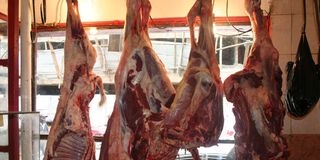Bacteria in meat causing UTIs, says study

Meat on display inside butchery in Nairobi. Bacteria found in meat is responsible for spiralling urinary tract infections (UTIs) in the United States, American scientists have said.
Bacteria found in meat is responsible for spiralling urinary tract infections (UTIs) in the United States, American scientists have said.
Over half a million UTIs in the US are linked to E coli strains found in meat sold in grocery stores, the study says.
UTIs usually occur in the bladder or urethra, but more serious infections involve the kidney, with the infections also most common among women.
These findings come at a time another study in Kenya has also flagged meat products sampled from Nakuru County for contamination with coliforms and E. coli with a prevalence of 100 per cent.
E coli is a type of bacteria commonly found in the intestines of animals, including cows and other livestock. The American study was conducted by a team of scientists from the George Washington University (GWU) Milken Institute School of Public Health, led by Lance Price and Cindy Liu. The findings were released on February 28, this year.
They developed a new genomic approach for tracing the origins of E coli infections and estimated that between 480,000 and 640,000 UTIs are caused by foodborne E coli strains annually in the US.
The bacteria can also be found in meat products that come from these animals, especially if the meat is not properly cooked or handled. When humans consume contaminated meat products, the E coli bacteria can infect the urinary tract, causing painful and uncomfortable UTIs.
Dr Lance B Price, a professor of environmental and occupational health and co-director of the Antibiotic Resistance Action Centre at GWU’s Milken Institute School of Public Health, emphasised the importance of being vigilant about hand hygiene and surface cleanliness when bringing meat products into the home.
“The most important thing is to make sure that you are very aware of washing your hands and the surfaces in your kitchen when you bring these products into your house,” said Dr Price.
In findings released on March 30, this year, three Kenyan researchers from the Department of Dairy and Food Science and Technology at Egerton University found that meat products they sampled from Nakuru County were contaminated with coliforms and E coli with a prevalence of 100 per cent.
The study, titled “Antimicrobial resistance in meat products in Kenya’’, which has been submitted to for review at the Social Science Research Network, is a cross-sectional analysis covering four locations with high populations of consumers of ready-to-eat (RTE) foods.
A total of 105 RTE red meat samples were collected from various outlets and transported to Egerton University for microbial analysis. The study found that there was a significant difference in the level of total coliforms and E coli contamination in different meat products, with boiled and stewed RTE meat products having significantly higher contamination levels than offals, roasted meat, and sausages.
Contamination levels
According to the report, the sampling location also had a significant effect on the contamination levels, with RTE meat products from Kikopey and Langalanga having significantly lower contamination levels than those from Salgaa, Shabaab, and the Nakuru City centre.
The study found that all of the E coli samples had at least two genes that make them resistant to antibiotics. Some samples were resistant to up to four antibiotics.
The E coli bacteria were found to be most resistant to cotrimoxazole, tetracycline, streptomycin, and ampicillin. The resistance levels varied in different places, with butcheries showing the highest levels of resistance to streptomycin and ampicillin.
Food-borne infections are a big problem around the world, causing many people to get sick and even die each year. These infections are mainly caused by bacteria found in contaminated food.
Foods that are ready to eat are especially at risk of being contaminated because of poor food handling practices and unclean environments.





